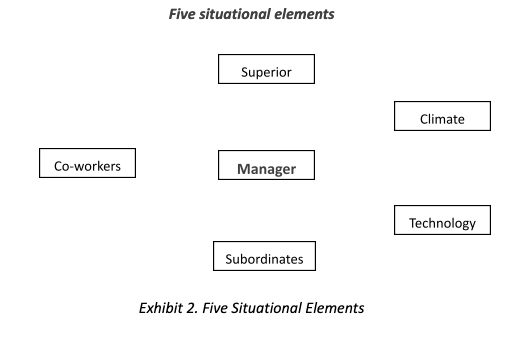¿Qué encontrarás en este artículo?
ToggleW.J. Reddin
Abstract The Managerial Effectiveness Seminar (MES) has been used in many countries including those of the Third World. The identical seminar, with its precise timings and identical design, is used in any country. It is six days in length, residential and has 50-100 hours of prework. The seminar design is explained and related to how the design allows the seminar to be transnational. Key design features include its underlying theory, its emphasis on effectiveness not profit, rigorous staff training, unusual role of staff and control of the environment.
Some Evidence of Transnationality
- The MES has been conducted in these countries: Argentina, Australia, Belgium, Brazil, Canada, Eire Ethiopia, Finland, Germany, Guyana, Jamaica, Kenya, Mexico, Netherlands, Norway, Singapore, South Africa, Spain, Sweden, Trinidad & Tobago, United Kingdom, United States of America and Venezuela.
- The first MES was conducted during May 1963 in Fredericton, New Brunswick, Canada. The participants were the top management structure of a 3,000 person power utility. The resultant effects of that early seminar are well documented by the then CEO (Tweeddale, 1967), and reprinted (Reddin, 1970; pp. 317-25) and again reprinted in abbreviated form (Reddin, 1985; pp. 170-3).
- One of our staff members, this year, conducted two MESs back to back in Ethiopia. They wanted two, and back to back, because of the overwhelming response to prior ones there. The seminar was attended, in the main, by the most senior government and military officials of this Marxist country. About a month later the absolutely identical seminar, was conducted by the same staff member for the CEO and supervisors of the largest cattle ranch in Texas, which is almost a capitalistic country in its own right. Both seminars were very well received as suiting the specific needs of participants.
- One of the world’s largest electrical equipment manufacturers with over 300,000 employees, recently bought the rights for this seminar for use within their company worldwide. The company operates in over 30 countries.
The point to be made is that a management seminar can be made truly transnational. The argument is not that they all should be, only that some can be.
Design Issues which have helped the MES become Transnational
There are several design issues which have helped the MES become transnational.
- The theory: The theory surrounding managerial effectiveness is non-ideological. It does not push for one style rather than another or, even implicitly, push for one political philosophy rather than another. It is a transnational theory of managerial effectiveness.
- Managerial effectiveness first: The concept of managerial effectiveness, not necessarily profit, is the starting and ending point of the seminar. This is clearly a common interest worldwide.
- The detailed design: The seminar has been tested and retested over many years in many countries.
- Control of seminar environment: Most trainers believe in the concept of cultural island. We believe in it very much and take it very seriously. We aim for virtual complete control of the seminar environment.
- Staff role and quality of training: We put enormous effort into teaching staff their role on this seminar and improving them as trainers, generally. Too many have said to us that it is the best training experience they have ever had. This is from experienced trainers. What we say, basically, is ‘Please get yourself out of it and let the participants get into it’.
- Introducing seminars in translation: There is a fairly simple method of introducing seminars in translation as long as a few know the English language. They normally do.
- Editing of seminar material: We make a very careful edit of seminar material so it does not reflect sexual differences, particular currencies, time frames, the value of effectiveness vs. profits and status difference in organisations. All this obviously helps transnationally.
The Theory
The approach on which the seminar is based involves effectiveness, situation and style as represented in Exhibit One. Surely this idea is transnational.
This can be read in either direction. Management style, essentially management behaviour, is an input to a situation and if the style matches the situation, then effectiveness will result. Looked at another way, effectiveness arises from the situation if the right behaviour is used. This general approach is referred to as the 3-D Theory of Managerial Effectiveness.
Five situational elements: It is relatively easy to specify a variety of managerial styles and it is also relatively easy to be clear about effectiveness and its definition. What is much more difficult is to be clear about situation so that it is accepted transnationally. The 3-D Theory assumes that there are five main situational elements each of which exert influence on a manager and each of which the manager may have to manage (see Exhibit 2). How well the manager responds to these situational elements or how well the manager changes their demands will have a direct bearing on the manager’s effectiveness.
The situation is defined in terms of five situational elements: Organisation, Climate, Technology, Superior, Co-workers and Subordinates. In order for a manager to be effective, it is necessary to be able to sense what each element requires. This is clearly transnational.
Common sense: The only problem with common sense in management is that it is not very common. Surely, one of the enormous strengths of Peter Drucker is that he writes common sense. His work is probably more widely transnational than that of any management writer. The 3-D Theory attempts to apply common sense, as Drucker does. It is supposed to be common sense that applies in any organisation at all levels in any country.
Beliefs inherent in 3-D: There are some beliefs which arise clearly from the basic structure of the 3-D Theory. These are:
- Managerial effectiveness is the central issue in management.
- Behaviour must match situation needs for effectiveness to occur.
- Style flexibility is the key to effectiveness.
- Unambiguous indicators of effectiveness must be developed and be under constant assessment.
- It is more effective to provide an opportunity for people to use what they already know than to teach them more.
- Participative methods are advisable when the quality of the decision is likely to be improved or if commitment to implement the decision is likely to be improved.
Managerial Effectiveness First
One of the main reasons for acceptance of this transnational seminar is that the seminar itself does not put profit first. This must be left to the organisation as a function of organisation type and philosophy. It might be a church or voluntary organisation. Marxist countries are quite willing to argue the virtue of managerial effectiveness. For some political systems profit is obviously a virtue, for others it is an anathema. But, all can accept managerial effectiveness.
It is apparent that managerial effectiveness is not a one sided concept; it is a value all countries can embrace. Whatever our personal values, objectives, moral philosophy, or political orientation, managerial effectiveness is a life-line. It says ‘Use resources productively, waste less, and make work enjoyable and worthwhile’. The question is not ‘Should I be nice to people?’, or on the other hand, ‘What rules should be followed?’, but ‘What does it take to be effective here?’ It says nothing about ‘More power to the workers’ or ‘keep the workers down’. It does not argue for higher profit. It simply says ‘Measure managers by the extent to which they achieve the output requirements of their positions’.
Potential for profit improvement: It is not the main intention of this article to indicate the potential for profit improvement by using the MES: However, in profit making organisations this is, of course, a central concern. In one country, 1 of 10 divisions of Westinghouse, the Switchgear Division decided to use the MES. All 10 divisions were of roughly, equal size, with about 1,000 employees each. To start, only one used the MES. At the start all had about a 6% return on investment. The one using the MES had a 36% return on investment about three years later while the others remained about where they were.
A large bank was actually embarrassed by its $ 100 million profit. It started using the MES. Five years later the profits were over $·350 million. A small brewery of about 100 employees decided to use the MES. Their profits doubled over three years. Their sole competitor virtually went out of business and eventually sold out to a national chain. For some organisations, in some countries, profit is the orientation. In other types of organisations in other countries it has nothing whatsoever to do with the effectiveness of the organisation. Profit is easy to measure, quality of client service is much harder to measure. This is the main reason that these indicators of profit improvement have been mentioned. There are, of course, dozens of other indicators of improvement.
The MES has not yet been conducted in any iron curtain country. Obviously, we hope it will be and believe it will be and see no reason why it should not be. The seminar deals with people and organisations not with politics in any of its aspects. Peking is interested and a potential sponsoring national institution asked whether the 3-D Theory and the MES would be a good way to improve the measurement of the effectiveness of production managers. We thought this was a rather narrow expectation but that may be where they are at the moment.
The Detailed Design
The MES is a six-day, residential, instrumented laboratory. The seminar starts at 15.30 p.m. on the first day, and ends at 12.30 p.m. on the sixth day. This time span normally covers Sunday evening to Friday noon. Hours are long. Each morning starts promptly at 8.00 a.m. in the main room. Teams frequently work from then until past midnight. About 80% of the seminar takes place in team rooms with five to eight managers, which approximates the usual span of control. Participants with close working relationships, such as superior to subordinate or co-worker may attend the same seminar, but are not placed together on the same team.
The MES confronts the teams with a wide variety of problems to solve, generally related to methods of achieving managerial effectiveness through the recognition of the reality of a situation and the best approach to it. Teams solve problems in their team rooms, then meet with other teams in the main room to report on their decisions and to compare their effectiveness in making them and in reaching them.
The objective of the MES is to internalise the skills, knowledge and beliefs of the 3-D Theory of Managerial Effectiveness in such a way that they become part of the manager’s day to day work life. The participants are provided with one central objective for the seminar in the opening minutes. It is ‘The objective of this seminar is to help you become more objective about your situation so you can engage it better and therefore become more effective’. In short, overcoming distortions to engage reality.
The seminar is carefully designed so that while participants will perceive some of the issues raised as mildly stressful, no participant will be unduly frustrated by the experience. No adverse effects have been observed over the years the seminar has been conducted. The MES fosters independence. The manager is required to confront the situation and to decide to engage it. Staff are carefully trained to avoid attempts by participants to transfer problems to them for solving.
In addition to being designed as transnational, the MES is specifically designed to be useful at all managerial and supervisory levels. In any organisation the identical seminar can be attended by the CEO and the lowest level supervisor. The absolutely identical seminar is used for CEOs, generals, admirals, high and low level civil servants, line crew supervisors, bottling line supervisors in a brewery, supervisors of cowhands on a ranch, PhDs and those with only a few years of any education. One series of seminars was attended by the middle and top management of the largest weapon system designer in the world, about 3,000 employees and half had their PhDs. At this same seminar were first line supervisors from a manufacturing plant. We believe they all learned a lot from each other. For reasons about which I am not quite clear the Jesuits have been interested in the seminar over a long period of time in many countries. The top Jesuit in Brazil has participated. The Jesuits in India wanted to take on the license for India. A few years ago I was giving a lecture at an Academy of Management annual meeting and a priest entered the room; I said ‘A Jesuit I presume?’ he replied affirmatively. The point is that the seminar is not simply transnational, it is translevel, transorganisation by types and, obviously, is transfunctional.
Five Stages of Learning:
The seminar can be seen as having five stages in learning:
Prework: Each participant receives a prework kit. This consists of three texts, wall charts and a seminar workbook. The basic text is Managerial Effectiveness (Reddin, 1984). This explains the 3-D Theory and shows how it is applied to improve effectiveness. The general seminar workbook contains questionnaires, style tests, effectiveness inventories, seminar tasks, case studies, team diagnosis instruments and other learning aids. Depending on the participant’s prior knowledge and individual capacity and dedication, seminar prework generally takes from 50 to 100 hours to complete.
Days one and two: This is concept mastery. Participants work in teams to deepen their understanding of the basic concepts relating to effectiveness, styles, situation and managerial behaviour. Teamwork skills are also learned during this period. Regular reviews of individual and team effectiveness are made.
Day three: This is case study application. Effectiveness concepts are applied to case studies so the practical application is demonstrated and learned. This day transfers theoretical learning into practical application. Team building skills are continually practised and reviewed.
Days four, five and six: This is application to self. The entire second half of the MES applies effectiveness concepts to the participant’s actual work situation. Day four is spent on effectiveness, day five on managerial behaviour, and day six on situation management. The last three days are highly involving for all participants. These three days end up with a detailed back home action plan for each participant.
Post seminar. This is on the job application. After the MES, managers use the conceptual and printed tools the 3-D MES has provided. They may use them to redefine their position in output terms, to work with subordinates, co-workers and their superior on objectives and also to change their less effective behaviour, or they may decide to change their work situation.
Self Awareness
A key step in improving effectiveness is in facing one’s own behaviour. If a manager believes that the style being used is relationships oriented when it is really task oriented, this distortion can only lead to lower effectiveness. The increased awareness needed is about one’s own behaviour, one’s own situation and one’s own effectiveness. The seminar accomplishes this by many techniques. An obvious and fairly straightforward one is to provide a variety of tests which have good social desirability controls, so that it is a fairly easy matter to compare the manager’s own perception of style with that of others on the seminar and with the reasonably accurate test itself. Another technique is to review case studies, to decide on the styles being used and then to compare these judgements with others on the seminar. The self awareness techniques are based very much on tested case studies and questionnaires and team discussion and agreement on results. In short, we think the best way to lower distortion level is to encourage feedback from others on the reality of the situation as presented. Obviously, this is precisely what we want to be used back home.
Our Insistence on Design Integrity
Many of the world’s most sophisticated training centres are using the MES as designed. They felt no need to redesign the seminar, that is, to add their egg to the cake mix. The reason they did not is that they were sophisticated. One user of the MES is the US Civil Service Commission who once spent half a million dollars on redesigning an appraisal form. They felt no need to redesign the MES but, rather clearly, they had the resources if they wished to do so. One of the longest users of the MES is the highly sophisticated General Motors Institute at Flint, Michigan. It is essentially the G. M. University. They could have ‘made’ anytime. They decided not to. They thought that the MES as designed was good enough. They have been our clients for over a decade. A worldwide organisation, where 3-D was introduced by a team of PhD level occupational psychologists, decided that to buy was better. Obviously, they could have made. They thought on balance they would not.
Control of Seminar Environment
Many aspects of the seminar design, certainly including staff role, and the nature of hotel administration, are deliberately designed to inhibit the manifestation of local cultural influences. There seems little point in attempting to convey what is meant by managerial effectiveness if there is absolutely anything wrong with hotel administration, such as waiting for meals or if each day does not start on the dot at 8.00 a.m., even though only one of the teams may be in the main room (you only have to do it once).
Many key elements of seminar design serve to inhibit local cultural influences. These influences may not be national but may be simply the differences between a steel mill and a bank in the same city. Some of these key design elements include that we insist on 100% detailed and complete control of hotel administration. Our hotel guide is 14 pages long. We simply ask the hotel ‘Can you deliver, or not?” We also ask them “If things go wrong at any time of the day or night who do we call? Preferably the owner”. This tends to get their attention. Several individual hotels, and certainly hotel chains, have received over a million dollars in accommodation revenue directly as a function of the MES. This point, when made to “new” hotels really makes them co-operative. One hotel in the UK is in its 16th year with us. One hotel in Canada is in its 17th year. We like them as long as we have complete control of the environment. We call the shots, not the chef, or the duty manager. A married team were once conducting the MES in a remote village in Argentina. As the seminar essentially runs itself, they went shopping one afternoon. They went down the hill from the hotel. The shopkeeper said something like “Are you staying at the hotel? I understand the military has moved in and they will not let anybody out”.
Open-ended Hours
The seminar is deliberately and carefully designed to be open-ended in terms of hours. While it always starts promptly at 8.00 a.m., there is no formal close on any day except the last day at 12.30 p.m. The evening tasks are designed to be relatively open-ended and somewhat difficult. This leads to teams working very late, and we think, learning more. Teams have been known to work through the night, take a quick shower at 7.30 a.m., and be in the main room at 8.00 a.m. The staff know when the team is in trouble when they observe an “early close”. That would be anything before 11.30 p.m. There is, of course, no published schedule. There is little question that these design features lead to teams learning more. They are asked to reach consensus and not stop until they do. Learning consensus is very difficult and we think it is best taught by this type of method. Also, the long hours tend to fray nerves and sometimes this encourages openness much earlier in the seminar than might otherwise occur.
In the early days we experimented at length with some nights off. It became pretty clear that there was no learning on nights off. On incompany seminars what they do is to visit a participant’s room and talk about their own problems incompany. Well, the seminar is designed to provide that anyway. In short, all of our staff believe that it is better to give no “nights off” and simply to work the group through the whole experience with no spare time.
Staff Role and Quality of Training
Much thought has been given to the appropriate staff role. Some may be surprised how the role is designed. Also much thought and development has been given to how to train staff best. If one thinks that the basis of the seminar is transnational then it has to be carried by people who can reasonably act as transnationals. Transnational seminars should not be conducted by those who simply carry their own culture around in their hip pocket. So, our training is faintly fierce. We do not want our staff members to reflect their personality that much, their company culture that much or their country that much. Obviously, some cannot handle this. They do not like it.
About one in six potential staff members fail to qualify. The virtually exclusive reason might be termed intrusive personal needs. Some want to look intelligent, so they talk too much. Some elaborate too much unnecessarily. Some want to be the centre of attention and so interfere with the learning. Some are over-responsive to authority, these unconsciously indicate by their verbal or non-verbal behaviour that the more senior person at coffee breaks is somehow better. They over-react to the senior person. The really naive ones sometimes propose that all the senior persons be put on the same team. That is an absolute killer, as any good organisation development person would know. Obviously, that team would finish first and learn least. Some staff members who fail are simply over anxious. The seminar can induce anxiety for new staff. One staff member, about five minutes before being due to give a rationale for a difficult case study that had not been studied well enough developed an immediate acute toothache. Some of our best staff members are members of what may be reasonably called the most senior training institutions in each of Finland, Germany and the USA. They are quite willing to conduct the MES one week and a Kepner Tregoe course a few weeks later. One aspect of unconsciously serving one’s own needs, is staff under training who change the nature of their dress around Thursday. They do it to either indicate that their job is done or they feel good about themselves. One trainer actually wore a tie and jacket on Thursday. This was saying “I am finished now”. Another trainer on Thursday decided to put on a Mickey Mouse watch and wear multi-coloured pants. This was saying “Love me”. There is no need to fail them for these things, as long as they learn to never do it again. There are literally dozens of stories about like this. More broadly, staff members who fail do not truly believe that management development means self development. The logical consequence is that help means low interference and not denying the natural learning experience.
Key rules for staff members: There are several key rules for staff. The rules are designed so that the personality of the staff member does not interfere with the learning of the participants. These rules may be strange to some but they have been widely accepted by about 200 highly experienced trainers. Staff members never offer help in team rooms. As about 80% of the seminar takes place in team rooms, staff members normally visit around the team rooms. The fixed rule however is that they may not help teams in any way. If they see a team in flight or in fight, or in any other mode, they make no comment. If they are asked questions they deflect them. If the staff member should volunteer some comment we interpret this as trying to impress the team and obviously not trying to be helpful to the team. If the team asks the staff member to help them, we interpret this as dependence. No concepts of the seminar are that difficult that a team could not work them out easily and well if they wish to. There is always a latent issue being addressed and the issue should be left up to the team to identify and resolve. It is all too easy to defuse an important argument by offering help. There is much the same kind of rule in the main room. In the main room the staff member gives a talk and assigns a task and does not solve team problems. A typical question that might arise is “What is the difference between flex and flexibility? One team does not understand it”. What is happening here is that the team wanted staff member to solve a problem, a very simple problem, that the team, for some reason, has not been able to solve. If a staff member gives the answer the team is denied the chance to learn. Obviously, good staff members become adroit at avoiding these things. It is possible that many readers of this article will find that this violates their sensibilities. Our staff have not the slightening objection to giving answers, clear detailed answers, on a quite different seminar, probably lasting a day which is highly cognitive, but that is not the MES.
Mix of staff: Most seminars are attended by two staff members. When there are only two licensed incompany staff members there is no discretion over who might conduct a particular seminar. However, when there are no internal staff, when new countries are involved or public seminars are involved, care can be paid to staff selection. Ethiopians are outgoing, friendly, relationships oriented people. They are also tough bargainers. Within these dimensions they are exactly like Texans. So, who attended both of these seminars as a staff member? The staff person who attended knew their style well, and was much like them.
In what later turned out be probably the largest Organisation Development Assignement in the world, I had to select the two staff members to conduct the first two incompany seminars for our potential OD client. Knowing Australia well I selected the staff members with care. One was about 52, who often defines himself as a country bumpkin. He is a soft, cuddly relationships oriented type. No threat.
The other was a much younger, very fit, active sportsman. The type who enjoyed and did play tennis for three hours some mornings. My assumption, cannot demonstrate it, is that with these two completely different people, quite obviously, believing in the same thing, it is very difficult for participants not to believe there must be something in it. As a by the way, the cuddly one has been thrown in the hotel pool. It seems right. As for the tennis “sport” the seminar had another idea. This good staff member, let it be known that he was an active tennis player. In Australia they have a term “cutting down the tall poppy”. Australia is a culture of the average person and if you stick your head up too high they like to chop it off, in a purely friendly way. As it happened, this first seminar had one of the top tennis seeds in Australia in attendance. Obviously, the participants did not let this staff member know this. However, they arranged a 7.00 a.m. ‘friendly’ match. The entire seminar turned out to watch. You know the result. Still, the seminar started at 8.00 a.m. Ultimately we do insist on staff control.
Staff members are trained to use one phrase reasonably uniformly. The phrase is “This is a team problem”. At times there are limits to the use of this. One team member was rejected by the team and, basically, told to “go away for a while”. Obviously, this increases anxiety and therefore lowers perception. On going back to the hotel room the toilet beckoned. Because of lowered perception, it was not noticed that the floor of the toilet was being retiled and had fresh tar over it. The participant soon confronted the two staff members, in his underpants, carrying a pair of trousers covered in tar. There was anger in the air. The problem was compounded because the source of his anger was a combination of self, the team, and the hotel. The junior staff member, under training, spontaneously blurted out “This is a team problem”. What happened at this point is best left to the imagination. Well, life is better than fiction and all this is true
Article published in: Management Education and Development,
Vol. 17, Pt. 3, 1986, pp. 257-270.











